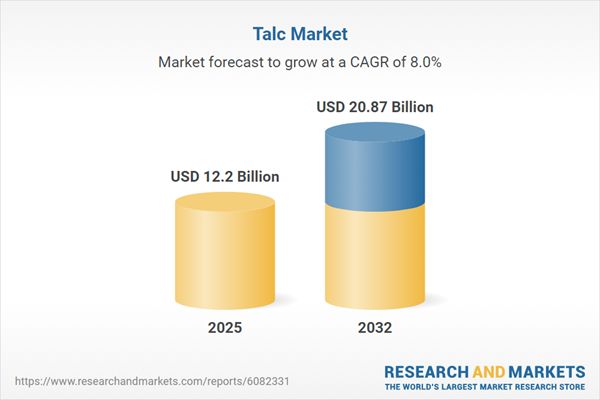Speak directly to the analyst to clarify any post sales queries you may have.
The talc market is evolving rapidly as industries seek materials that balance performance, cost-efficiency, and sustainability. Its importance spans from manufacturing to consumer products, requiring decision-makers to stay well-informed about current trends, technology drivers, and supply chain dynamics for effective planning.
Market Snapshot: Talc Market Growth and Dynamics
The talc market grew from USD 11.29 billion in 2024 to USD 12.20 billion in 2025. It is expected to continue growing at a CAGR of 7.98%, reaching USD 20.87 billion by 2032. Driven by increasing adoption in ceramics, plastics, coatings, cosmetics, and pharmaceuticals, the talc industry is witnessing steady expansion globally. Market growth is reinforced by innovation in advanced ceramics and performance plastics, rising demand for sustainability, and the move toward high-purity grades for specialty uses. As regulations tighten and technological advancements reshape end uses, manufacturers and suppliers are adapting to meet evolving customer and compliance expectations.
Scope & Segmentation of the Global Talc Industry
This report provides a comprehensive analysis of the talc market’s breadth, detailing product, application, form, grade, and geography. Key segments include:
- Applications: Ceramics (Refractories, Sanitary Ware, Tiles), Cosmetics & Personal Care (Body Makeup, Face Makeup, Talcum Powder), Food (Animal Feed, Food Additives), Paints & Coatings (Architectural, Industrial), Paper & Pulp (Packaging, Printing & Writing, Tissue), Pharmaceuticals (Oral Dosage, Tablet Excipients), and Plastics & Rubber (Elastomers, Thermoplastics, Thermosets).
- Grades: Ceramics Grade, Cosmetic Grade, Food Grade, Paint Grade, Paper Grade, Pharmaceutical Grade, Plastic Grade.
- Forms: Granular, Powder.
- Distribution Channels: Direct, Distributor, Online (Manufacturer Website, Marketplace).
- Purity: High Purity, Standard Purity.
- Regional Coverage: Americas (United States, Canada, Mexico, Brazil, Argentina, Chile, Colombia, Peru), Europe, Middle East & Africa (United Kingdom, Germany, France, Russia, Italy, Spain, Netherlands, Sweden, Poland, Switzerland, United Arab Emirates, Saudi Arabia, Qatar, Turkey, Israel, South Africa, Nigeria, Egypt, Kenya), and Asia-Pacific (China, India, Japan, Australia, South Korea, Indonesia, Thailand, Malaysia, Singapore, Taiwan).
- Leading Companies Covered: Imerys SA, Minerals Technologies Inc., Rio Tinto plc, Golcha Enterprises Pvt. Ltd., TOLSA S.A., Franklin Minerals Inc., Mondo Minerals B.V., Nippon Talc Co., Ltd., Guizhou Panjiang Talc & Limestone Co., Ltd., and Krosaki Harima Corporation.
Key Takeaways for Senior Decision-Makers
- Talc’s role as a material of choice in high-performance manufacturing is propelled by advancements in micronization, surface modification, and purity enhancement technologies.
- Sustainability and mineral traceability are influencing procurement strategies, requiring investment in blockchain and digital supply chain solutions for compliance and brand integrity.
- Industry players are strengthening collaborative R&D partnerships to accelerate innovation in new formulations for packaging, pharmaceuticals, and performance coatings.
- Segmentation by form, grade, and distribution channel allows companies to tailor their portfolios and align with the specific needs of end markets ranging from personal care to engineered plastics.
- Regional market opportunities stem from both mature ecosystems and the emergence of Asia-Pacific as a manufacturing and consumption hub, each demanding tailored go-to-market approaches.
- Competitive strategies are shifting toward digitalization in quality management, end-user transparency, and customer-centric service models, helping firms strengthen their market position.
Tariff Impact on Supply Chains and Cost Structures
New US tariffs in 2025 have altered global supply chains, increasing the drive for domestic production and compelling manufacturers to diversify sourcing. Sourcing adjustments, longer-term contracts, and joint development of alternative mineral blends have become standard tactics as firms balance supply security with cost and quality considerations. These tariff-driven shifts have reshaped competitive positioning and spurred capacity investment within key regions.
Methodology & Data Sources
The analysis combines in-depth interviews with executives, regulators, and industry associations with secondary research from technical journals and company disclosures. Data triangulation and scenario analysis ensure findings accurately capture sector drivers, risks, and opportunities, segmenting the talc market across application, grade, and regional dimensions.
Why This Report Matters for Talc Industry Leaders
- Enables strategic planning by analyzing the impact of technology innovation, sustainability trends, and regulatory shifts on procurement, supply chain, and product development.
- Provides actionable segmentation detail to identify and prioritize emerging growth niches across global regions and industries.
- Delivers insight on adapting to policy changes and strengthens the competitive toolkit with regional and end-market perspectives.
Conclusion
Understanding the talc market’s evolving structure and trends equips decision-makers to anticipate regulatory, technological, and supply chain challenges. This research supports informed decisions aimed at securing sustainable growth across the global talc value chain.
Table of Contents
3. Executive Summary
4. Market Overview
7. Cumulative Impact of Artificial Intelligence 2025
List of Figures
Samples

LOADING...
Companies Mentioned
The key companies profiled in this Talc market report include:- Imerys SA
- Minerals Technologies Inc.
- Rio Tinto plc
- Golcha Enterprises Pvt. Ltd.
- TOLSA S.A.
- Franklin Minerals Inc.
- Mondo Minerals B.V.
- Nippon Talc Co., Ltd.
- Guizhou Panjiang Talc & Limestone Co., Ltd.
- Krosaki Harima Corporation
Table Information
| Report Attribute | Details |
|---|---|
| No. of Pages | 189 |
| Published | October 2025 |
| Forecast Period | 2025 - 2032 |
| Estimated Market Value ( USD | $ 12.2 Billion |
| Forecasted Market Value ( USD | $ 20.87 Billion |
| Compound Annual Growth Rate | 7.9% |
| Regions Covered | Global |
| No. of Companies Mentioned | 11 |









